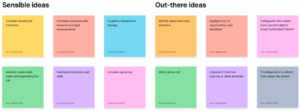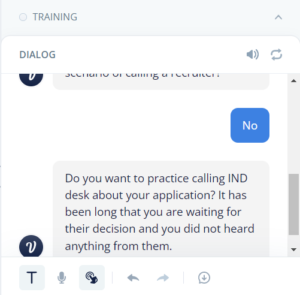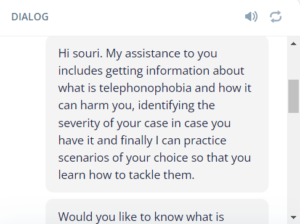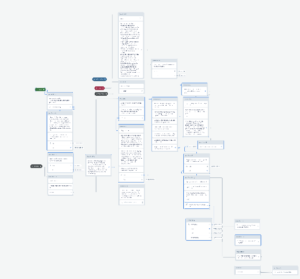Premise
Creating a voice chatbot against telephonophobia
Synopsis
Telephonophobia is a type of social anxiety disorder that challenges a major population of millennials. Millennials prefer text messages over phone calls. The reasons could be that they do not know what to say or do not know how to say that or even they forgot to mention what they were about to say due to excessive stress caused by telephonophobia. Therefore, the therapist chatbot should facilitate the lack of information and communication problems among millennials. The chatbot should use voice functionality to mimic a real phone call. Voice-to-text and text analysis assist in analyzing the user response and progress of improvement.
Introduction
The Internet explosion had a double side effect on Millennials’ lives. Information and guidance become easier to achieve (Winograd and Hais, 2014) meanwhile competition among them went higher. Economic recessions made the situation worse since it happened just at the time that they were looking for their first job. Dimock (2018) claimed that the recession determinably affected the adulthood, earning, and life choices of millennials.
According to Luttrell and McGrath (2015), 61 percent of millennial office workers are having problems with responding and making phone calls. Making and responding to phone calls is stressful for them (Von Dawans et al., 2018). Hence, millennials face challenges in the workplace, in their job interviews, and while calling authorities consequently.
The fear of making or responding to phone calls is called telephonephobia (Marshall, 1995 in Varghese, 2013). Not seeing the listener and not receiving visual feedback from the other side complicates the situation (Varghese, 2013) for individuals. This problem made many organizations think about knowing their customers with telephonophobia and providing specific assistance for them.
Technology-based therapies against phobias have been used for a long time however current systems fail in providing a full experience due to limited speech interactions (Ter Heijden et al., 2010). To solve this problem, Ter Heijden et al.(2010) suggested using chatbots. Chatbots use text and/ or voice and Artificial Intelligence (AI), to interact and provide information (Oh et al., 2020). Therapeutical approaches using chatbot should consider the fact that different level of anxiety requires different attention. Predicting stress levels caused by phobias plays a substantial role in the choices and deployment of the therapy method. Matsumoto et al. (2021) suggested the following steps considering specific cases:
o Assessment of the user (severity),
o Solution and treatment based on the severity,
o Improve mental resistance to the results of the user assessment (learning)
Planned situation
It was targeted that the individuals using BellA (our therapeutic assistant), at the end of therapy sessions, could be able to make calls or respond to their formal calls without feeling any stress caused by telephonophobia.
Design and Iterations
First Iteration
Many tools were examined for this prototype. Finally, Voiceflow has been identified as the best fit for this study due to its voice functionalities and developments. Considering the severity of the phobia challenging the users, BellA practices telephonic skills, with a millennial, aiming to eradicate the loss of opportunities and to eliminate legal and financial losses. This chatbot fills the gap in two steps:
Step 1- information gap: they don’t know what to say – for this reason and in the first step, the focus of the chatbot is on removing the fear caused by unknowns. Throughout this phase, the chatbot provides tips and examples of correct possible answers.
Step 2- voice distraction – In this stage, BellA simulates a real conversation by shifting the conversation from text to voice. In this step, we are expecting the user to try to handle emotions while talking and look for the best answers and effectively spell them.


The chatbot uses voice-to-text to convert the text response and then develop a text analysis of the responses. The chatbot improves interactions by learning from each conversation.
The prototype has been tested through three rounds of iterations. The number of users in all user testing is equal (5 users). The users are not limited to a certain geographical location and could be everyone having two main conditions:
- They are born between 1977 and 1997 and,
- They experienced severe telephonophobia in a way that they considerably suffered from that.
Next table is the description of pre-test questions:
| User id | Age | occupied | job | gender | aware of it? | asked for assistance? | how it was? | interested scenario? |
| u1 | 34 | yes | law firm | man | no | no | talking with authorities | |
| u2 | 37 | part-time | Tailor | woman | yes | no | talking with recruiter | |
| u3 | 26 | no | woman | yes | no | talking with recruiter | ||
| u4 | 32 | yes | GP | woman | yes | yes | websites | talking with boss and colleagues |
| u5 | 36 | yes | engineer | man | yes | no | talking with authorities and colleagues |
The feedback and insight from users contributed to improving the prototype. In this step, we should more focus on what our users are doing and not on what they say. As claimed by Baecker et al. (2000), users even may not know what they want.
Feedbacks
The general feedback for the first test was that the user was confused between scenarios and needed scenarios to be directed to him/her one by one (because they need an explanation for each scenario and see if they are interested in that practice or not). They expected more personalized practice.
In the initial design, they had the option to choose text or voice and change in between (in each step of the practice). The main feedback regarding that was that they rather not go through the mixed practice and they found it more desirable to start with text and move to the voice call after mastering the concept and collecting information about the call and the skills in responding to questions over the call.
The feedback from the first iteration (how the experience was) and analysis of user responses has been used to improve the model and then be tested in the second round.
Second Iteration
The second iteration had three major improvements: adding the assessment form, detailed scenarios, and division of text and voice in the therapeutic procedure.
- In the initial design, the assessment form was not included. Therefore, there was no control over the users that attend testing. Therefore, in the next iteration, the assessment procedure is added to the prototype to make sure that the user is identified as a severe case. To develop the assessment criteria (for the assessment procedure), standard forms such as the “Social Phobia Diagnostic Questionnaire” developed by Newman et al. (2003) and the “fear questionnaire” developed by Marks and Mathews (1979) has been used. The assessment helps with measuring the improvements as well.
- To design the scenarios in the therapeutic process, this study interviewed millennials suffering from telephonophobia (users of the first round) and a therapist to improve the scenarios. Also, to add a more personalized experience, a flow to ask the name of the user (along with a short description of telephonophobia and the chatbot) has been added before the assessment form. Detailed scenarios were developed in this round. To develop the scenarios, we considered the following Important points:
- Who is the user?
- Why does the user is using the chatbot?
- What are the users’ goals?
- How can the user achieve them?
Considering the results of the interviews and feedback from the first round, the scenarios have been updated and limited to two scenarios: Calling a recruiter and receiving a call from the immigration office.
- For practicing with the voice, just after the users show their consent to move to the voice call, the chatbot asks them to open their microphone and continue the treatment using the knowledge he/she gained in the last step. The chatbot, in this stage, just analyses their responses based on using the keywords they learned (in the last step).


Feedbacks
The main feedback received from users was about the voice-to-text functionality of the prototype (the chatbot was not correctly hearing). It was suggested to consider more suitable technical requirements (for voice) and advise the users to test the prototype in a quiet and isolated room.
Sometimes the users want to resume the scenario selection step. To make sure that they do not redo the assessment, the start-over intent (as a second-level intent) has been added, in the next round. This intent redirects the conversation to the point that the user can choose between scenarios.
In general, testing this showed that the users were more happy in this round. They sent positive feedback about the prototype and the therapeutic procedure.
Final Iteration
The final iteration includes a description regarding services offered by the chatbot and adds some intents like start over, help, and information that made the experience more structured and pleasant. To show the progress of improvement by BellA, final feedback at the end of each practice has been developed. For that, timestamps and variables introducing each scenario have been added.



Conclusion
The voice chatbot has been proven to be helpful in the treatment of telephonophobia. In a phone call, we cannot see the body language and expressions on the face of the person on the other side of the call. Removing the element of sight (as it imitates the real phone call) by voice chatbot was helpful in this approach.
Providing information and practicing them, before adding the element of voice, help individuals to fight against fewer challenges. Voice increases distraction, stress, and being annoyed. Emotion analysis on voice could be used, in the future, to better measure stress.
References
Baecker, R., Booth, K., Jovicic, S., McGrenere, J., & Moore, G. (2000, November). Reducing the gap between what users know and what they need to know. In Proceedings on the 2000 conference on Universal Usability (pp. 17-23).
Dimock, M. (2018). Defining generations: Where Millennials end and post-Millennials begin. Pew Research Center, 1, 87-102.
Luttrell, R., & McGrath, K. (2016). The millennial mindset: Unraveling fact from fiction. Rowman & Littlefield.
Marks, I. M., & Mathews, A. M. (1979). Brief standard self-rating for phobic patients.Behaviour Research & Therapy, 17, 263–267
Matsumoto, A., Kamita, T., Tawaratsumida, Y., Nakamura, A., Fukuchimoto, H., Mitamura, Y., … & Inoue, T. (2021). Combined Use of Virtual Reality and a Chatbot Reduces Emotional Stress More Than Using Them Separately. J. Univers. Comput. Sci., 27(12), 1371- 1389.
Newman, M. G., Kachin, K. E., Zuellig, A. R., Constantino, M. J., & Cashman-McGrath, L. (2003). The Social Phobia Diagnostic Questionnaire: Preliminary validation of a new selfreport diagno
Oh, J., Jang, S., Kim, H., & Kim, J. J. (2020). Efficacy of mobile app-based interactive cognitive behavioral therapy using a chatbot for panic disorder. International journal of medical informatics, 140, 104171.
Ter Heijden, N., Qu, C., Wiggers, P., & Brinkman, W. P. (2010). Developing a dialogue editor to script interaction between virtual characters and social phobic patients. In ECCE2010 Workshop on cognitive engineering for technology in mental health care and rehabilitation (pp. 111-123)
Varghese, R. T. (2013). Mobile phone phobia in persons with stuttering-Indian scenario
Von Dawans, B., Trueg, A., Kirschbaum, C., Fischbacher, U., & Heinrichs, M. (2018). Acute social and physical stress interact to influence social behavior: The role of social anxiety. PloS one, 13(10), e0204665
Winograd, M., & Hais, M. (2014). How millennials could upend Wall Street and corporate America. Governance Studies at Brookings, 5, 19-27.)

